service indicator MINI COOPER CONVERTIBLE 2016 Owners Manual
[x] Cancel search | Manufacturer: MINI, Model Year: 2016, Model line: COOPER CONVERTIBLE, Model: MINI COOPER CONVERTIBLE 2016Pages: 252, PDF Size: 5.41 MB
Page 83 of 252
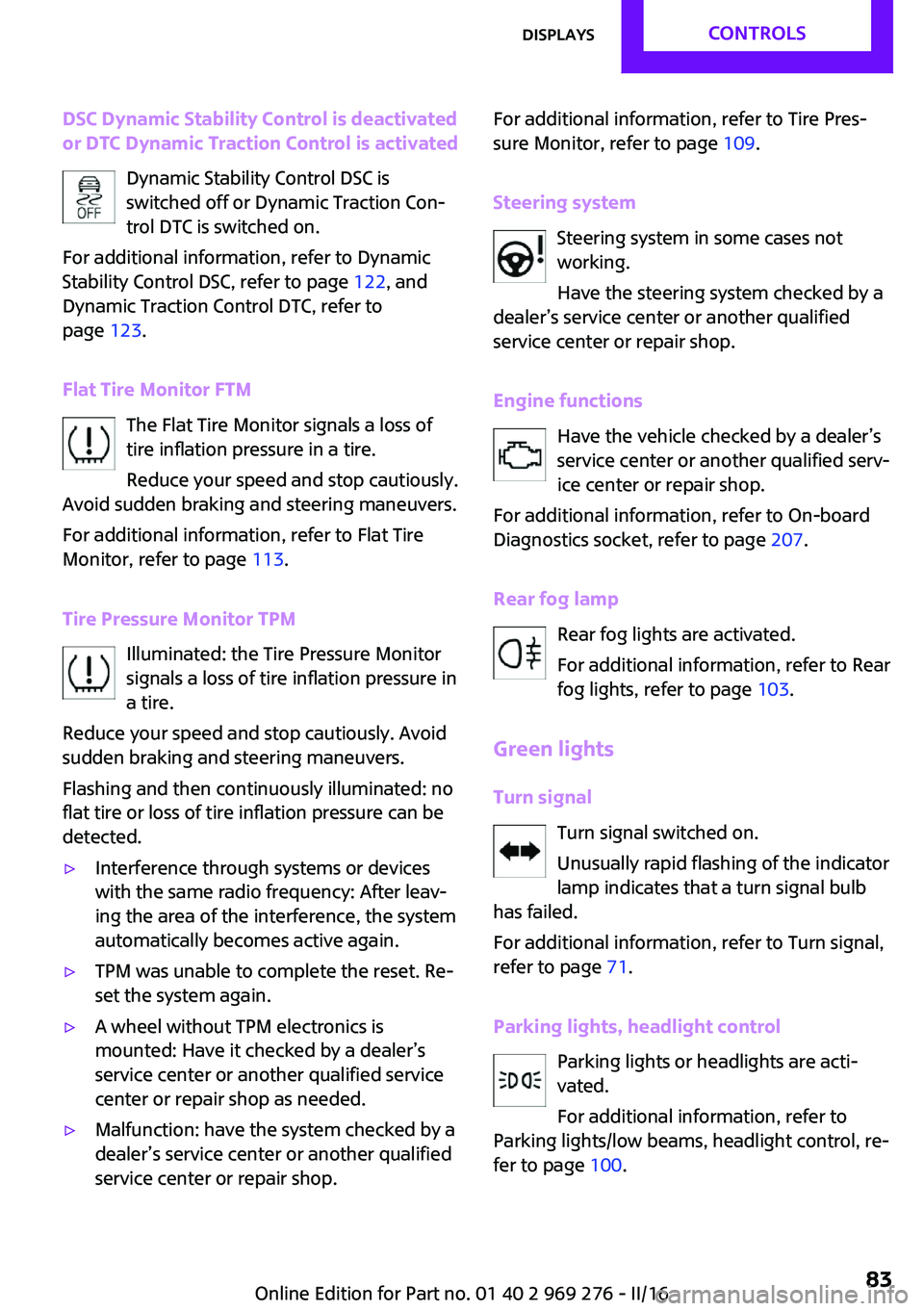
DSC Dynamic Stability Control is deactivated
or DTC Dynamic Traction Control is activated
Dynamic Stability Control DSC is
switched off or Dynamic Traction Conā
trol DTC is switched on.
For additional information, refer to Dynamic
Stability Control DSC, refer to page 122, and
Dynamic Traction Control DTC, refer to
page 123.
Flat Tire Monitor FTM The Flat Tire Monitor signals a loss of
tire inflation pressure in a tire.
Reduce your speed and stop cautiously.
Avoid sudden braking and steering maneuvers.
For additional information, refer to Flat Tire
Monitor, refer to page 113.
Tire Pressure Monitor TPM Illuminated: the Tire Pressure Monitor
signals a loss of tire inflation pressure in
a tire.
Reduce your speed and stop cautiously. Avoid
sudden braking and steering maneuvers.
Flashing and then continuously illuminated: no
flat tire or loss of tire inflation pressure can be
detected.ā·Interference through systems or devices
with the same radio frequency: After leavā
ing the area of the interference, the system
automatically becomes active again.ā·TPM was unable to complete the reset. Reā
set the system again.ā·A wheel without TPM electronics is
mounted: Have it checked by a dealerās
service center or another qualified service
center or repair shop as needed.ā·Malfunction: have the system checked by a
dealerās service center or another qualified
service center or repair shop.For additional information, refer to Tire Presā
sure Monitor, refer to page 109.
Steering system Steering system in some cases not
working.
Have the steering system checked by a
dealerās service center or another qualified
service center or repair shop.
Engine functions Have the vehicle checked by a dealerās
service center or another qualified servā
ice center or repair shop.
For additional information, refer to On-board
Diagnostics socket, refer to page 207.
Rear fog lamp Rear fog lights are activated.
For additional information, refer to Rear
fog lights, refer to page 103.
Green lights Turn signal Turn signal switched on.
Unusually rapid flashing of the indicator
lamp indicates that a turn signal bulb
has failed.
For additional information, refer to Turn signal,
refer to page 71.
Parking lights, headlight control Parking lights or headlights are actiā
vated.
For additional information, refer to
Parking lights/low beams, headlight control, reā
fer to page 100.Seite 83DisplaysCONTROLS83
Online Edition for Part no. 01 40 2 969 276 - II/16
Page 84 of 252
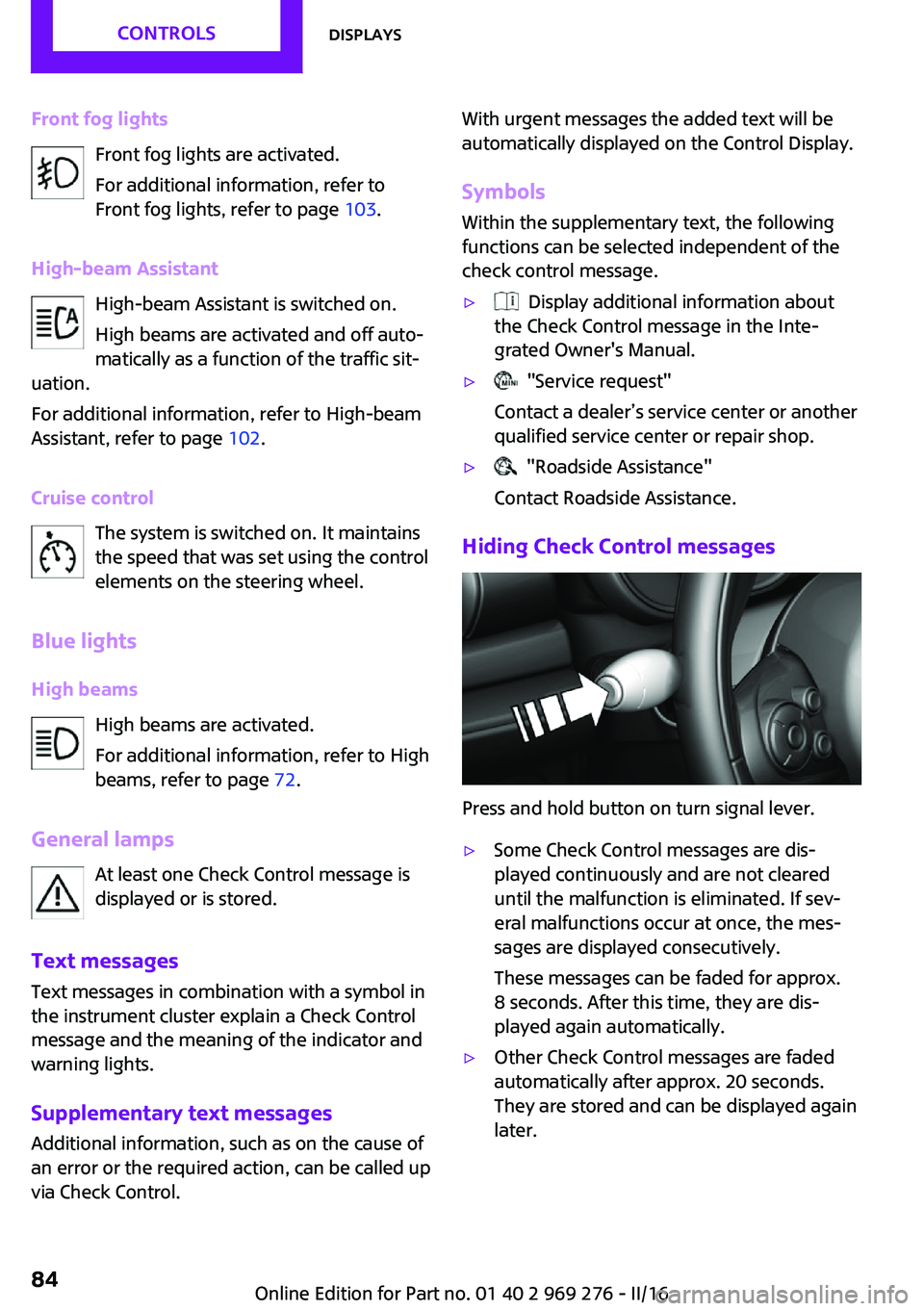
Front fog lightsFront fog lights are activated.
For additional information, refer to
Front fog lights, refer to page 103.
High-beam Assistant High-beam Assistant is switched on.
High beams are activated and off autoā
matically as a function of the traffic sitā
uation.
For additional information, refer to High-beam
Assistant, refer to page 102.
Cruise control The system is switched on. It maintains
the speed that was set using the control
elements on the steering wheel.
Blue lights
High beams High beams are activated.
For additional information, refer to High
beams, refer to page 72.
General lamps At least one Check Control message is
displayed or is stored.
Text messages
Text messages in combination with a symbol in
the instrument cluster explain a Check Control
message and the meaning of the indicator and
warning lights.
Supplementary text messages
Additional information, such as on the cause of
an error or the required action, can be called up
via Check Control.With urgent messages the added text will be
automatically displayed on the Control Display.
Symbols
Within the supplementary text, the following
functions can be selected independent of the
check control message.ā· Display additional information about
the Check Control message in the Inteā
grated Owner's Manual.ā· "Service request"
Contact a dealerās service center or another
qualified service center or repair shop.ā· "Roadside Assistance"
Contact Roadside Assistance.
Hiding Check Control messages
Press and hold button on turn signal lever.
ā·Some Check Control messages are disā
played continuously and are not cleared
until the malfunction is eliminated. If sevā
eral malfunctions occur at once, the mesā
sages are displayed consecutively.
These messages can be faded for approx.
8 seconds. After this time, they are disā
played again automatically.ā·Other Check Control messages are faded
automatically after approx. 20 seconds.
They are stored and can be displayed again
later.Seite 84CONTROLSDisplays84
Online Edition for Part no. 01 40 2 969 276 - II/16
Page 87 of 252
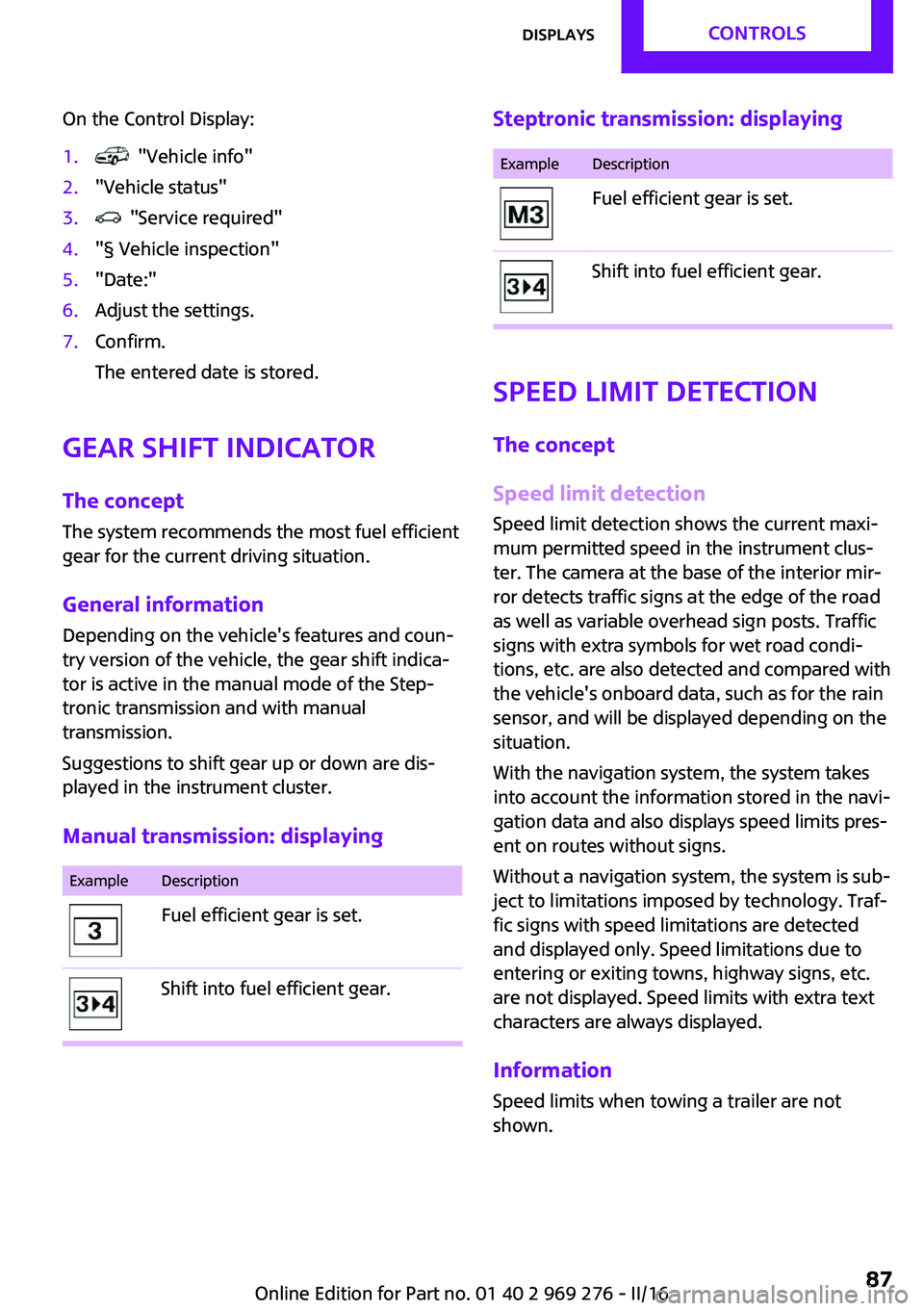
On the Control Display:1. "Vehicle info"2."Vehicle status"3. "Service required"4."Ā§ Vehicle inspection"5."Date:"6.Adjust the settings.7.Confirm.
The entered date is stored.
Gear shift indicator
The concept
The system recommends the most fuel efficient
gear for the current driving situation.
General information Depending on the vehicle's features and counā
try version of the vehicle, the gear shift indicaā
tor is active in the manual mode of the Stepā
tronic transmission and with manual
transmission.
Suggestions to shift gear up or down are disā
played in the instrument cluster.
Manual transmission: displaying
ExampleDescriptionFuel efficient gear is set.Shift into fuel efficient gear.Steptronic transmission: displayingExampleDescriptionFuel efficient gear is set.Shift into fuel efficient gear.
Speed limit detection
The concept
Speed limit detection
Speed limit detection shows the current maxiā
mum permitted speed in the instrument clusā
ter. The camera at the base of the interior mirā
ror detects traffic signs at the edge of the road
as well as variable overhead sign posts. Traffic
signs with extra symbols for wet road condiā
tions, etc. are also detected and compared with
the vehicle's onboard data, such as for the rain
sensor, and will be displayed depending on the
situation.
With the navigation system, the system takes
into account the information stored in the naviā
gation data and also displays speed limits presā
ent on routes without signs.
Without a navigation system, the system is subā
ject to limitations imposed by technology. Trafā
fic signs with speed limitations are detected
and displayed only. Speed limitations due to
entering or exiting towns, highway signs, etc.
are not displayed. Speed limits with extra text
characters are always displayed.
Information
Speed limits when towing a trailer are not
shown.
Seite 87DisplaysCONTROLS87
Online Edition for Part no. 01 40 2 969 276 - II/16
Page 97 of 252
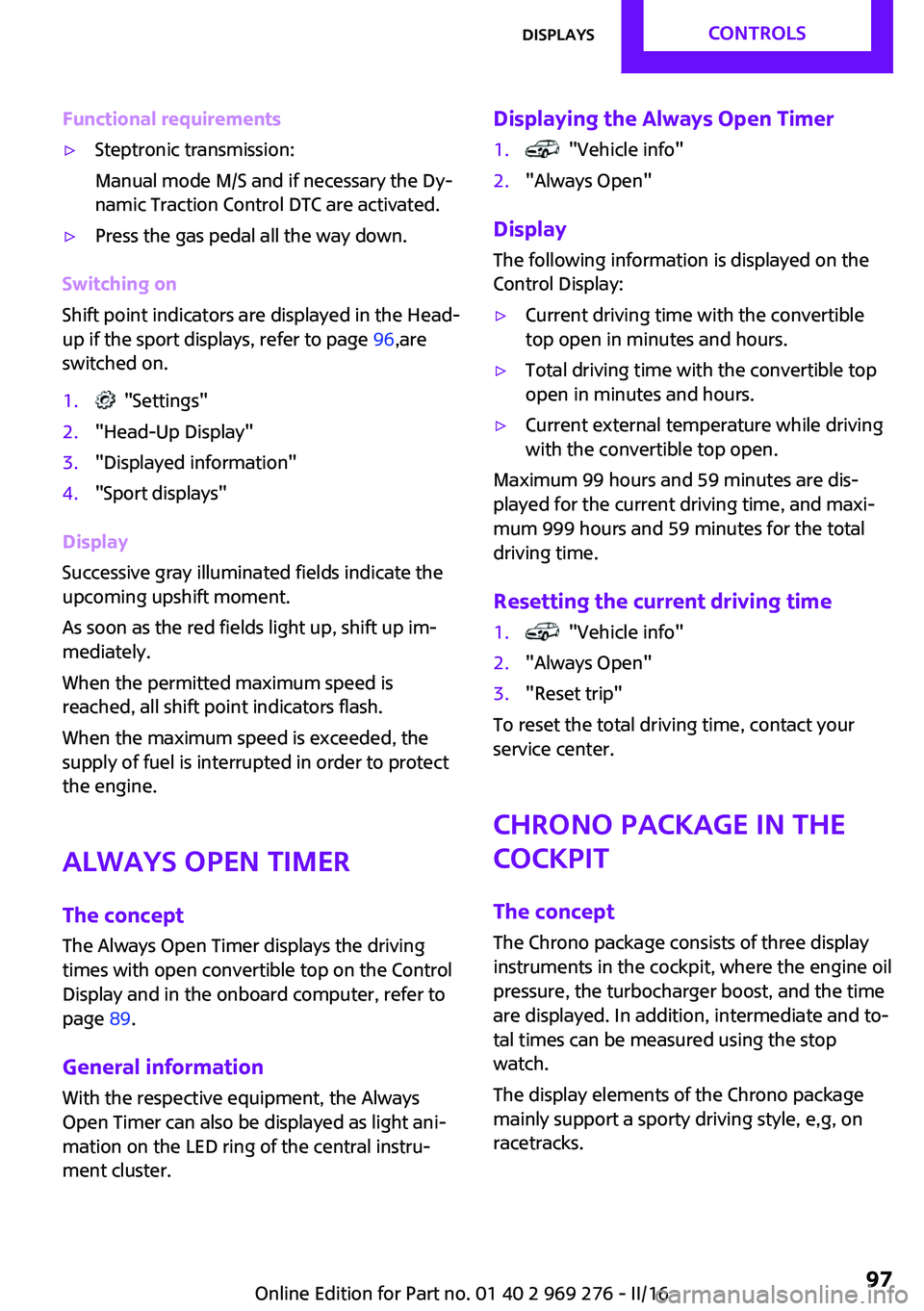
Functional requirementsā·Steptronic transmission:
Manual mode M/S and if necessary the Dyā
namic Traction Control DTC are activated.ā·Press the gas pedal all the way down.
Switching on
Shift point indicators are displayed in the Head-
up if the sport displays, refer to page 96,are
switched on.
1. "Settings"2."Head-Up Display"3."Displayed information"4."Sport displays"
Display
Successive gray illuminated fields indicate the
upcoming upshift moment.
As soon as the red fields light up, shift up imā
mediately.
When the permitted maximum speed is
reached, all shift point indicators flash.
When the maximum speed is exceeded, the
supply of fuel is interrupted in order to protect
the engine.
Always Open Timer The concept
The Always Open Timer displays the driving
times with open convertible top on the Control
Display and in the onboard computer, refer to
page 89.
General information
With the respective equipment, the Always
Open Timer can also be displayed as light aniā
mation on the LED ring of the central instruā
ment cluster.
Displaying the Always Open Timer1. "Vehicle info"2."Always Open"
Display
The following information is displayed on the
Control Display:
ā·Current driving time with the convertible
top open in minutes and hours.ā·Total driving time with the convertible top
open in minutes and hours.ā·Current external temperature while driving
with the convertible top open.
Maximum 99 hours and 59 minutes are disā
played for the current driving time, and maxiā
mum 999 hours and 59 minutes for the total
driving time.
Resetting the current driving time
1. "Vehicle info"2."Always Open"3."Reset trip"
To reset the total driving time, contact your
service center.
Chrono package in the
cockpit
The concept The Chrono package consists of three display
instruments in the cockpit, where the engine oil
pressure, the turbocharger boost, and the time
are displayed. In addition, intermediate and toā
tal times can be measured using the stop
watch.
The display elements of the Chrono package
mainly support a sporty driving style, e,g, on
racetracks.
Seite 97DisplaysCONTROLS97
Online Edition for Part no. 01 40 2 969 276 - II/16
Page 112 of 252
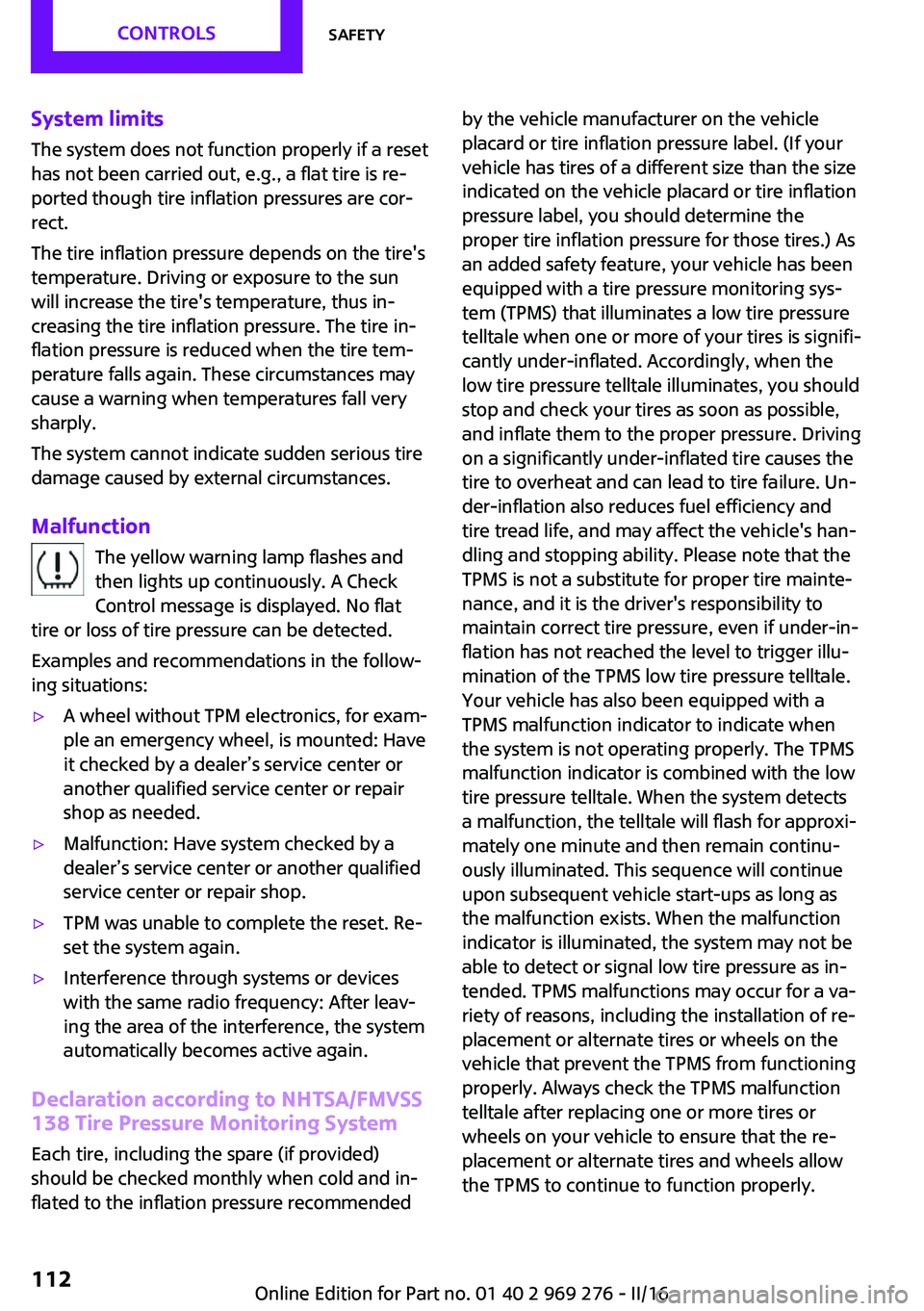
System limits
The system does not function properly if a reset
has not been carried out, e.g., a flat tire is reā
ported though tire inflation pressures are corā
rect.
The tire inflation pressure depends on the tire's
temperature. Driving or exposure to the sun
will increase the tire's temperature, thus inā
creasing the tire inflation pressure. The tire inā
flation pressure is reduced when the tire temā perature falls again. These circumstances may
cause a warning when temperatures fall very
sharply.
The system cannot indicate sudden serious tire
damage caused by external circumstances.
Malfunction The yellow warning lamp flashes and
then lights up continuously. A Check
Control message is displayed. No flat
tire or loss of tire pressure can be detected.
Examples and recommendations in the followā
ing situations:ā·A wheel without TPM electronics, for examā
ple an emergency wheel, is mounted: Have
it checked by a dealerās service center or
another qualified service center or repair
shop as needed.ā·Malfunction: Have system checked by a
dealerās service center or another qualified
service center or repair shop.ā·TPM was unable to complete the reset. Reā
set the system again.ā·Interference through systems or devices
with the same radio frequency: After leavā
ing the area of the interference, the system
automatically becomes active again.
Declaration according to NHTSA/FMVSS
138 Tire Pressure Monitoring System
Each tire, including the spare (if provided)
should be checked monthly when cold and inā
flated to the inflation pressure recommended
by the vehicle manufacturer on the vehicle
placard or tire inflation pressure label. (If your
vehicle has tires of a different size than the size
indicated on the vehicle placard or tire inflation
pressure label, you should determine the
proper tire inflation pressure for those tires.) As
an added safety feature, your vehicle has been
equipped with a tire pressure monitoring sysā
tem (TPMS) that illuminates a low tire pressure
telltale when one or more of your tires is signifiā
cantly under-inflated. Accordingly, when the
low tire pressure telltale illuminates, you should
stop and check your tires as soon as possible,
and inflate them to the proper pressure. Driving
on a significantly under-inflated tire causes the
tire to overheat and can lead to tire failure. Unā
der-inflation also reduces fuel efficiency and
tire tread life, and may affect the vehicle's hanā
dling and stopping ability. Please note that the
TPMS is not a substitute for proper tire mainteā
nance, and it is the driver's responsibility to
maintain correct tire pressure, even if under-inā
flation has not reached the level to trigger illuā
mination of the TPMS low tire pressure telltale.
Your vehicle has also been equipped with a
TPMS malfunction indicator to indicate when
the system is not operating properly. The TPMS
malfunction indicator is combined with the low
tire pressure telltale. When the system detects
a malfunction, the telltale will flash for approxiā
mately one minute and then remain continuā
ously illuminated. This sequence will continue
upon subsequent vehicle start-ups as long as
the malfunction exists. When the malfunction
indicator is illuminated, the system may not be
able to detect or signal low tire pressure as inā
tended. TPMS malfunctions may occur for a vaā
riety of reasons, including the installation of reā
placement or alternate tires or wheels on the
vehicle that prevent the TPMS from functioning
properly. Always check the TPMS malfunction
telltale after replacing one or more tires or
wheels on your vehicle to ensure that the reā
placement or alternate tires and wheels allow
the TPMS to continue to function properly.Seite 112CONTROLSSafety112
Online Edition for Part no. 01 40 2 969 276 - II/16
Page 174 of 252
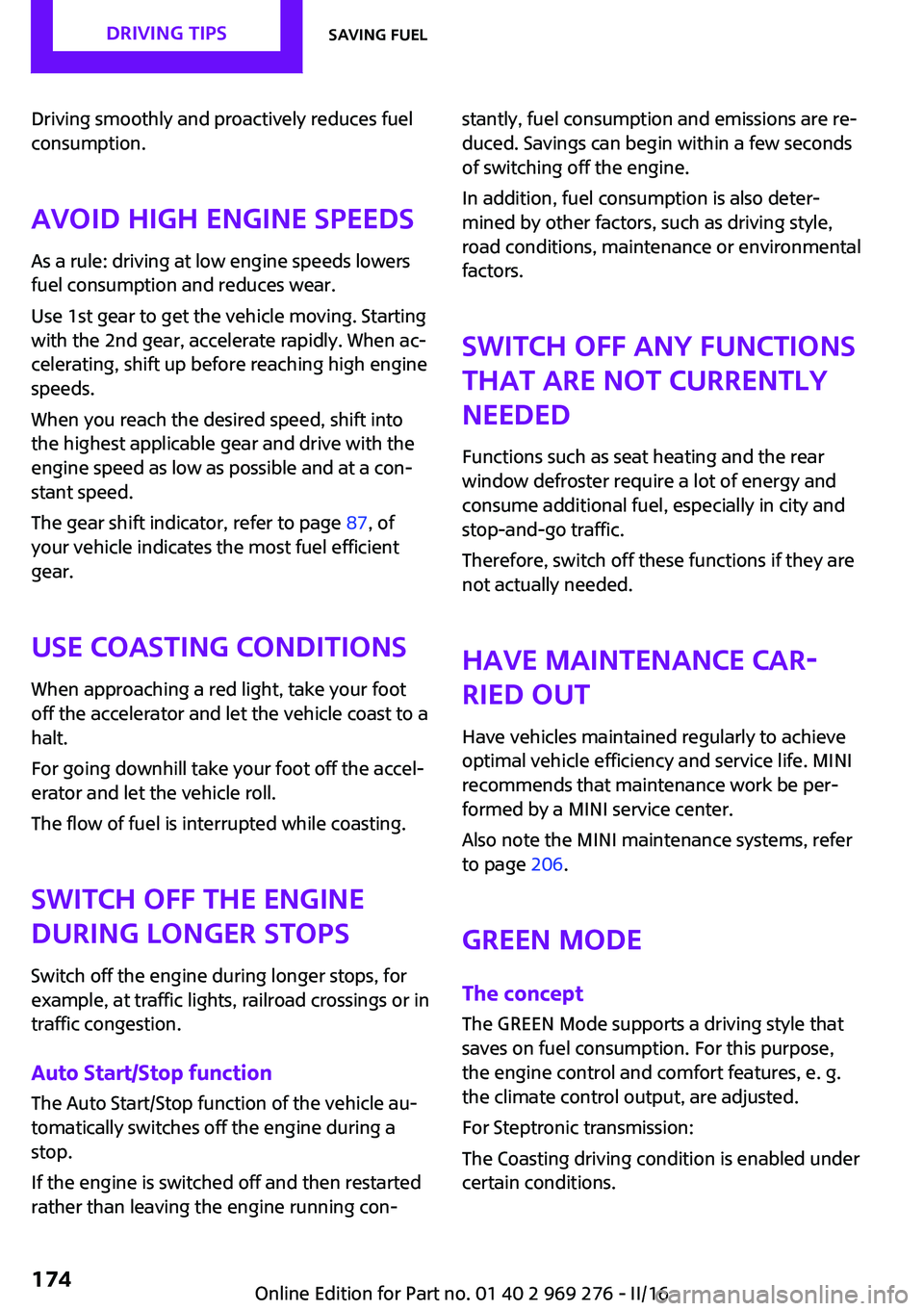
Driving smoothly and proactively reduces fuel
consumption.
Avoid high engine speeds
As a rule: driving at low engine speeds lowers
fuel consumption and reduces wear.
Use 1st gear to get the vehicle moving. Starting
with the 2nd gear, accelerate rapidly. When acā
celerating, shift up before reaching high engine
speeds.
When you reach the desired speed, shift into
the highest applicable gear and drive with the
engine speed as low as possible and at a conā
stant speed.
The gear shift indicator, refer to page 87, of
your vehicle indicates the most fuel efficient gear.
Use coasting conditions When approaching a red light, take your foot
off the accelerator and let the vehicle coast to a
halt.
For going downhill take your foot off the accelā
erator and let the vehicle roll.
The flow of fuel is interrupted while coasting.
Switch off the engine
during longer stops
Switch off the engine during longer stops, for
example, at traffic lights, railroad crossings or in
traffic congestion.
Auto Start/Stop function
The Auto Start/Stop function of the vehicle auā
tomatically switches off the engine during a
stop.
If the engine is switched off and then restarted
rather than leaving the engine running conāstantly, fuel consumption and emissions are reā
duced. Savings can begin within a few seconds
of switching off the engine.
In addition, fuel consumption is also deterā
mined by other factors, such as driving style,
road conditions, maintenance or environmental
factors.
Switch off any functions
that are not currently
needed
Functions such as seat heating and the rear
window defroster require a lot of energy and
consume additional fuel, especially in city and
stop-and-go traffic.
Therefore, switch off these functions if they are
not actually needed.
Have maintenance carā
ried out
Have vehicles maintained regularly to achieve
optimal vehicle efficiency and service life. MINI
recommends that maintenance work be perā
formed by a MINI service center.
Also note the MINI maintenance systems, refer
to page 206.
GREEN Mode
The concept The GREEN Mode supports a driving style that
saves on fuel consumption. For this purpose,
the engine control and comfort features, e. g.
the climate control output, are adjusted.
For Steptronic transmission:
The Coasting driving condition is enabled under
certain conditions.Seite 174DRIVING TIPSSaving fuel174
Online Edition for Part no. 01 40 2 969 276 - II/16
Page 244 of 252
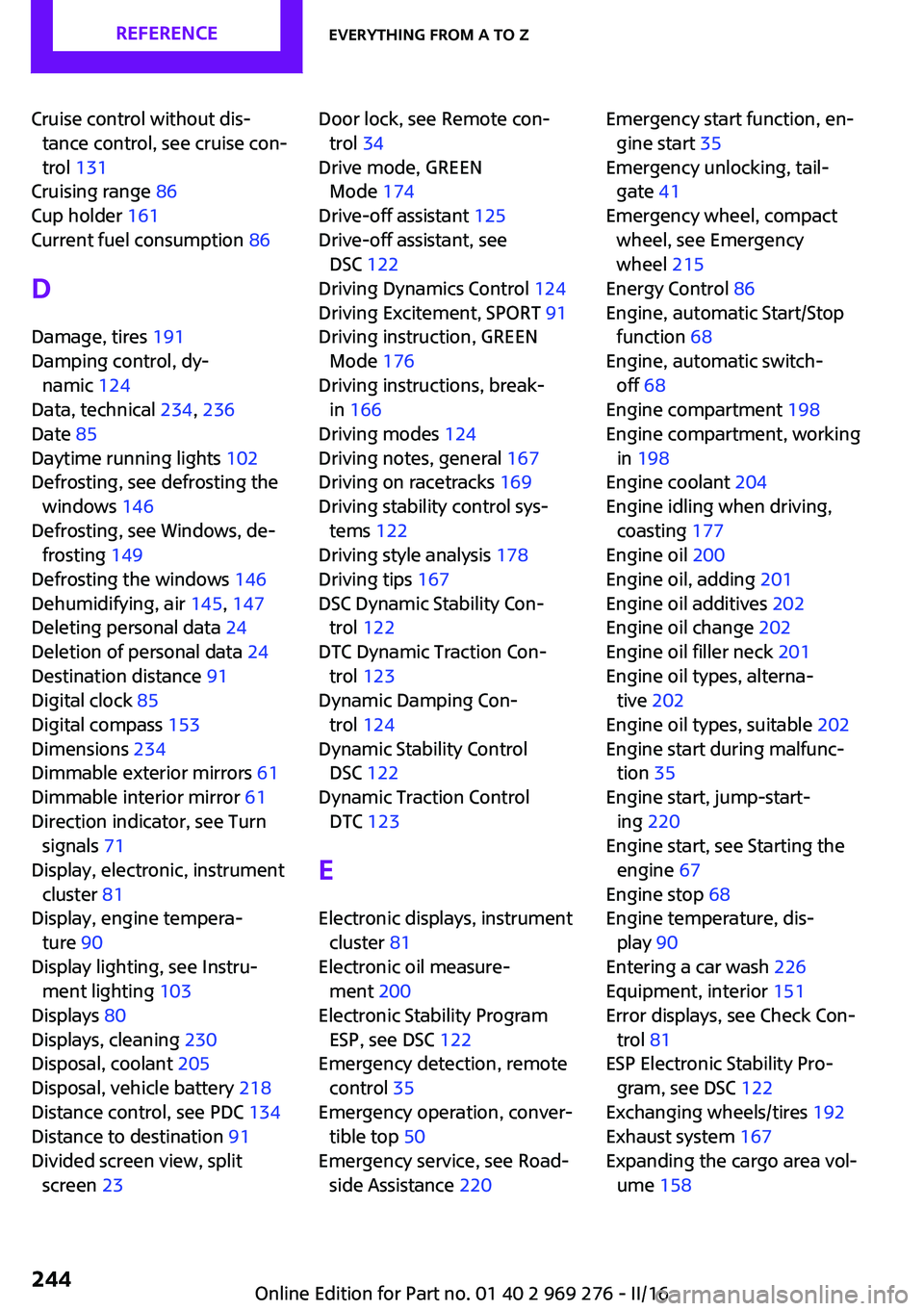
Cruise control without disātance control, see cruise conā
trol 131
Cruising range 86
Cup holder 161
Current fuel consumption 86
D
Damage, tires 191
Damping control, dyā namic 124
Data, technical 234, 236
Date 85
Daytime running lights 102
Defrosting, see defrosting the windows 146
Defrosting, see Windows, deā frosting 149
Defrosting the windows 146
Dehumidifying, air 145, 147
Deleting personal data 24
Deletion of personal data 24
Destination distance 91
Digital clock 85
Digital compass 153
Dimensions 234
Dimmable exterior mirrors 61
Dimmable interior mirror 61
Direction indicator, see Turn signals 71
Display, electronic, instrument cluster 81
Display, engine temperaā ture 90
Display lighting, see Instruā ment lighting 103
Displays 80
Displays, cleaning 230
Disposal, coolant 205
Disposal, vehicle battery 218
Distance control, see PDC 134
Distance to destination 91
Divided screen view, split screen 23 Door lock, see Remote conā
trol 34
Drive mode, GREEN Mode 174
Drive-off assistant 125
Drive-off assistant, see DSC 122
Driving Dynamics Control 124
Driving Excitement, SPORT 91
Driving instruction, GREEN Mode 176
Driving instructions, break- in 166
Driving modes 124
Driving notes, general 167
Driving on racetracks 169
Driving stability control sysā tems 122
Driving style analysis 178
Driving tips 167
DSC Dynamic Stability Conā trol 122
DTC Dynamic Traction Conā trol 123
Dynamic Damping Conā trol 124
Dynamic Stability Control DSC 122
Dynamic Traction Control DTC 123
E Electronic displays, instrument cluster 81
Electronic oil measureā ment 200
Electronic Stability Program ESP, see DSC 122
Emergency detection, remote control 35
Emergency operation, converā tible top 50
Emergency service, see Roadā side Assistance 220 Emergency start function, enā
gine start 35
Emergency unlocking, tailā gate 41
Emergency wheel, compact wheel, see Emergency
wheel 215
Energy Control 86
Engine, automatic Start/Stop function 68
Engine, automatic switch- off 68
Engine compartment 198
Engine compartment, working in 198
Engine coolant 204
Engine idling when driving, coasting 177
Engine oil 200
Engine oil, adding 201
Engine oil additives 202
Engine oil change 202
Engine oil filler neck 201
Engine oil types, alternaā tive 202
Engine oil types, suitable 202
Engine start during malfuncā tion 35
Engine start, jump-startā ing 220
Engine start, see Starting the engine 67
Engine stop 68
Engine temperature, disā play 90
Entering a car wash 226
Equipment, interior 151
Error displays, see Check Conā trol 81
ESP Electronic Stability Proā gram, see DSC 122
Exchanging wheels/tires 192
Exhaust system 167
Expanding the cargo area volā ume 158 Seite 244REFERENCEEverything from A to Z244
Online Edition for Part no. 01 40 2 969 276 - II/16
Page 246 of 252
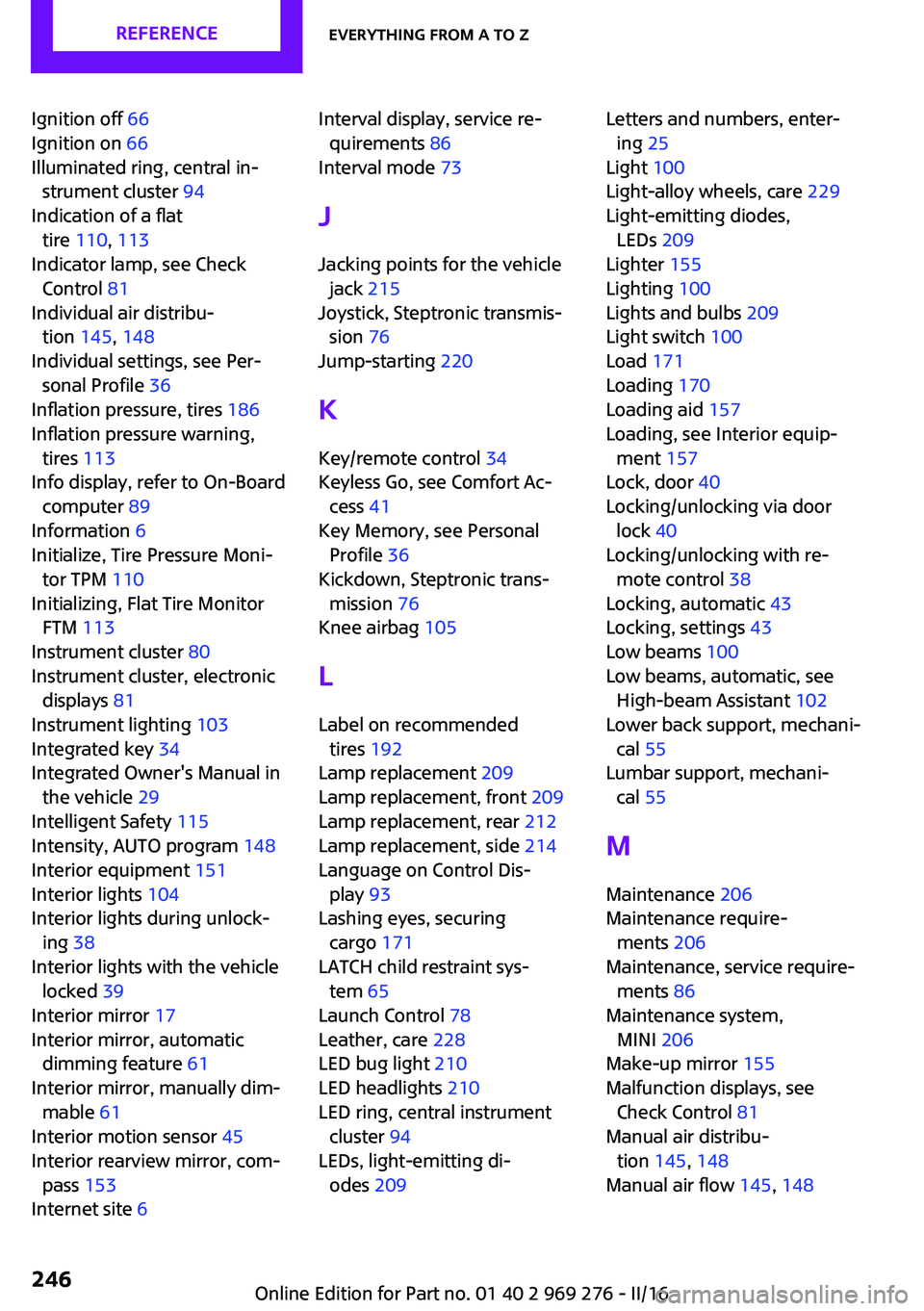
Ignition off 66
Ignition on 66
Illuminated ring, central inā strument cluster 94
Indication of a flat tire 110 , 113
Indicator lamp, see Check Control 81
Individual air distribuā tion 145, 148
Individual settings, see Perā sonal Profile 36
Inflation pressure, tires 186
Inflation pressure warning, tires 113
Info display, refer to On-Board computer 89
Information 6
Initialize, Tire Pressure Moniā tor TPM 110
Initializing, Flat Tire Monitor FTM 113
Instrument cluster 80
Instrument cluster, electronic displays 81
Instrument lighting 103
Integrated key 34
Integrated Owner's Manual in the vehicle 29
Intelligent Safety 115
Intensity, AUTO program 148
Interior equipment 151
Interior lights 104
Interior lights during unlockā ing 38
Interior lights with the vehicle locked 39
Interior mirror 17
Interior mirror, automatic dimming feature 61
Interior mirror, manually dimā mable 61
Interior motion sensor 45
Interior rearview mirror, comā pass 153
Internet site 6 Interval display, service reā
quirements 86
Interval mode 73
J Jacking points for the vehicle jack 215
Joystick, Steptronic transmisā sion 76
Jump-starting 220
K
Key/remote control 34
Keyless Go, see Comfort Acā cess 41
Key Memory, see Personal Profile 36
Kickdown, Steptronic transā mission 76
Knee airbag 105
L
Label on recommended tires 192
Lamp replacement 209
Lamp replacement, front 209
Lamp replacement, rear 212
Lamp replacement, side 214
Language on Control Disā play 93
Lashing eyes, securing cargo 171
LATCH child restraint sysā tem 65
Launch Control 78
Leather, care 228
LED bug light 210
LED headlights 210
LED ring, central instrument cluster 94
LEDs, light-emitting diā odes 209 Letters and numbers, enterā
ing 25
Light 100
Light-alloy wheels, care 229
Light-emitting diodes, LEDs 209
Lighter 155
Lighting 100
Lights and bulbs 209
Light switch 100
Load 171
Loading 170
Loading aid 157
Loading, see Interior equipā ment 157
Lock, door 40
Locking/unlocking via door lock 40
Locking/unlocking with reā mote control 38
Locking, automatic 43
Locking, settings 43
Low beams 100
Low beams, automatic, see High-beam Assistant 102
Lower back support, mechaniā cal 55
Lumbar support, mechaniā cal 55
M
Maintenance 206
Maintenance requireā ments 206
Maintenance, service requireā ments 86
Maintenance system, MINI 206
Make-up mirror 155
Malfunction displays, see Check Control 81
Manual air distribuā tion 145, 148
Manual air flow 145, 148 Seite 246REFERENCEEverything from A to Z246
Online Edition for Part no. 01 40 2 969 276 - II/16
Page 248 of 252
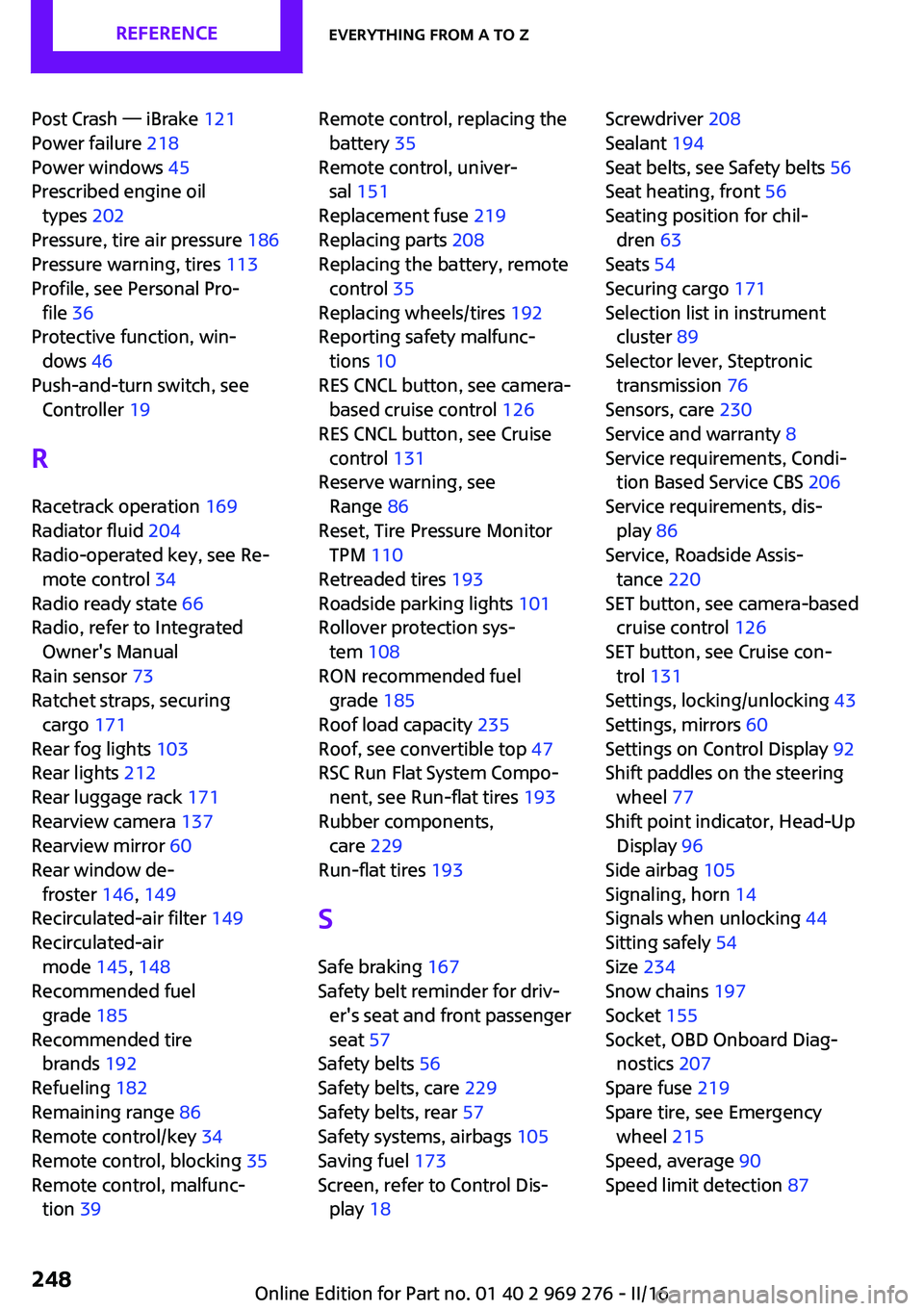
Post Crash ā iBrake 121
Power failure 218
Power windows 45
Prescribed engine oil types 202
Pressure, tire air pressure 186
Pressure warning, tires 113
Profile, see Personal Proā file 36
Protective function, winā dows 46
Push-and-turn switch, see Controller 19
R
Racetrack operation 169
Radiator fluid 204
Radio-operated key, see Reā mote control 34
Radio ready state 66
Radio, refer to Integrated Owner's Manual
Rain sensor 73
Ratchet straps, securing cargo 171
Rear fog lights 103
Rear lights 212
Rear luggage rack 171
Rearview camera 137
Rearview mirror 60
Rear window deā froster 146, 149
Recirculated-air filter 149
Recirculated-air mode 145, 148
Recommended fuel grade 185
Recommended tire brands 192
Refueling 182
Remaining range 86
Remote control/key 34
Remote control, blocking 35
Remote control, malfuncā tion 39 Remote control, replacing the
battery 35
Remote control, univerā sal 151
Replacement fuse 219
Replacing parts 208
Replacing the battery, remote control 35
Replacing wheels/tires 192
Reporting safety malfuncā tions 10
RES CNCL button, see camera- based cruise control 126
RES CNCL button, see Cruise control 131
Reserve warning, see Range 86
Reset, Tire Pressure Monitor TPM 110
Retreaded tires 193
Roadside parking lights 101
Rollover protection sysā tem 108
RON recommended fuel grade 185
Roof load capacity 235
Roof, see convertible top 47
RSC Run Flat System Compoā nent, see Run-flat tires 193
Rubber components, care 229
Run-flat tires 193
S Safe braking 167
Safety belt reminder for drivā er's seat and front passenger
seat 57
Safety belts 56
Safety belts, care 229
Safety belts, rear 57
Safety systems, airbags 105
Saving fuel 173
Screen, refer to Control Disā play 18 Screwdriver 208
Sealant 194
Seat belts, see Safety belts 56
Seat heating, front 56
Seating position for chilā dren 63
Seats 54
Securing cargo 171
Selection list in instrument cluster 89
Selector lever, Steptronic transmission 76
Sensors, care 230
Service and warranty 8
Service requirements, Condiā tion Based Service CBS 206
Service requirements, disā play 86
Service, Roadside Assisā tance 220
SET button, see camera-based cruise control 126
SET button, see Cruise conā trol 131
Settings, locking/unlocking 43
Settings, mirrors 60
Settings on Control Display 92
Shift paddles on the steering wheel 77
Shift point indicator, Head-Up Display 96
Side airbag 105
Signaling, horn 14
Signals when unlocking 44
Sitting safely 54
Size 234
Snow chains 197
Socket 155
Socket, OBD Onboard Diagā nostics 207
Spare fuse 219
Spare tire, see Emergency wheel 215
Speed, average 90
Speed limit detection 87 Seite 248REFERENCEEverything from A to Z248
Online Edition for Part no. 01 40 2 969 276 - II/16